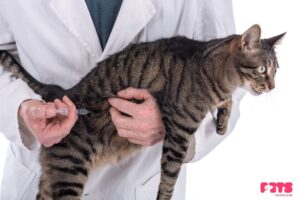Core Vaccines to Protect Your Cat
The FVRCP vaccine for cats is regarded as one of the most important immunizations your cat should have. Core vaccinations are generally safe for all cats, regardless of whether they spend more time indoors or outside. The Rabies vaccine is the opposite center vaccine for cats. It is not the most effectively endorsed vaccine, but it is also required via regulation in most states.
You may think your indoor cat is secure from infectious illnesses like those indexed underneath. But, the viruses that motivate these critical pussycat illnesses can live to tell the tale for up to a year on surfaces. This means that if your indoor cat sneaks outside, even for a brief time, they threaten to contract the virus and become critically ill.
In this article, we will study the situations in opposition to which the FVRCP vaccine can guard your cat while he must be vaccinated. We’ll also explain capacity reactions and aspect results of the FVRCP vaccine in cats and what to do if they occur.
As a cat proprietor, ensuring your tom cat associate gets all their cat vaccines on the agenda should be a top priority. The cat FVRCP vaccination ought to come first on the priority list. To maintain your cat’s immune towards the three risky airborne viruses panleukopenia, calicivirus, and rhinotracheitis, treat them with the feline FVRCP vaccine.
Conditions That The FVRCP Vaccine Protects Against
The FVRCP vaccine successfully protects your kitty accomplice from 3 rather contagious and existence-threatening feline diseases:
- Feline Viral Rhinotracheitis (the FVR part of the vaccine’s call)
- Feline Calicivirus (the C)
- Feline Panleukopenia (the P on the quit of the vaccine’s name)
- FHV-1 Cat Viral Rhinotracheitis
Cat herpesvirus type 1, also known as FVR, is known to cause 80–90% of commonly cat contagious respiratory tract illnesses. At an unknown risk, the illness may also affect your kitten’s nose, windpipe, and reproductive system.
Signs of FVR encompass infection of the eyes and nose, runny eyes and nostrils, fever, and sneezing. While these signs and symptoms can be slight in grownup cats and start cleansing up after 5 to ten days, FVR symptoms can close for six weeks or longer in extra severe instances.
FHV-1 symptoms may persist and get worse in kittens, older cats, and immunocompromised cats, leading to loss of appetite, extreme emaciation, sores within the mouth, and melancholy. In cats already affected by pussycat viral rhinotracheitis, bacterial infections regularly worsen their situation.
The virus may resurface in your cat’s body even after its first signs and symptoms have subsided. It is dormant inside your cat’s body.
FCV, or calicivirus in cats
This virus is a primary reason for cats’ higher respiration infections and oral disorders.
FCV, or calicivirus in cats signs and symptoms include nasal congestion, sneezing, eye infection, and clean or yellow discharge from the infected cat’s nostril or eyes. Some cats may additionally expand painful ulcers on their tongue, palate, lips, or nostrils due to FCV. Cats tainted with pussycat calicivirus frequently experience the ill effects of loss of inclination for food, weight decrease, fever, amplified lymph hubs, squinting, and torpidity.
It’s important to remember that there are quite some unique indications of FCV; some cause fluid buildup in the lungs (pneumonia), while others cause symptoms and side effects like a high temperature, pain in the joints, and weakness.
Panleukopenia in cats.

Cat Panleukopenia (FPL) is an over-the-top and routinely happening infection in felines that harms the bone marrow, lymph hubs, and cells coating your feline’s digestive organs. Dormancy, lack of hunger pangs, an elevated temperature, torpidity, spitting, a lot of loose stools, nostril discharge, and dehydration are some of the ideal effects.
Due to their weakened immune systems, cats inflamed with FPL regularly expand secondary infections as nicely. Although this disorder can assault cats of any age, it’s rarely fatal in kittens.
There are presently no medicinal drugs to be had to kill the virus that causes FPL, so treating cats with pussycat panleukopenia entails symptoms that include dehydration and surprise via intravenous fluid therapy and intensive nursing care.
When the vaccine is inoculated in your cat
To offer your tom cat pal the great feasible protection against FHV, FCV, and FPL, your cat needs to acquire its first FVRCP vaccine at around 6 to eight weeks of age, accompanied by a booster shot every 3 to 4 weeks till 16 to 20 weeks of age. Your kitten will need another booster while she’s just over a year old after which every 3 years for the rest of her life.
See our vaccination timetable for extra information on approximately whilst your cat must get hold of their vaccines.
FVRCP Cat Vaccine Cost

The expense of this immunization fluctuates depending upon the brand of antibody your doctor uses and where you reside. Your animal doctor can provide you with a gauge of the expense of the immunization.
Hazard of Secondary effects from the antibiotics
Side outcomes from vaccines are uncommon in cats, and after they do arise, they tend to be very mild. Most cats that revel in aspect outcomes will broaden a mild fever and feel a touch ‘off’ for a day. It isn’t always uncommon for there to be a small amount of swelling on the injection web page.
In some sporadic cases, more significant severe reactions can occur. In those cases, signs and symptoms generally appear before the cat has even left the vet’s office, although they can appear as much as 48 hours after the vaccination. The signs of a more fantastic intense reaction may consist of hives, swelling around the lips and eyes, itchiness, fever, diarrhea, vomiting, and respiration difficulties.
If your cat shows any more severe signs of a reaction indexed above, touch your vet immediately or visit the nearest emergency clinic.
Conclusion :
The FVRCP vaccine is one you don’t want to skip. This form of preventative medicine could mean the difference between serious contamination and a happy, healthy lifestyle for your pup. It needs to be administered as one of the primary vaccinations for cats and every three years in person. Do you remember the last time your cat got a vaccine? However, register yours within these days to make sure they are up to date and keep them locked for life.

